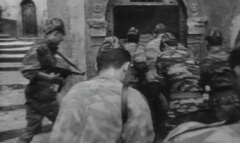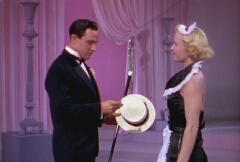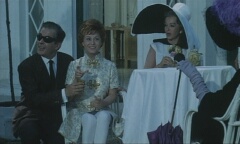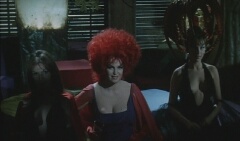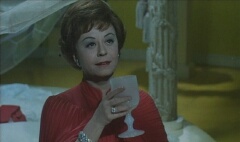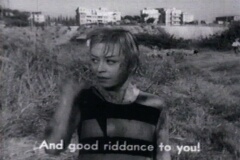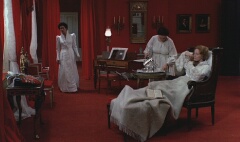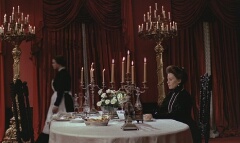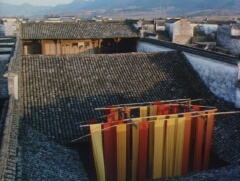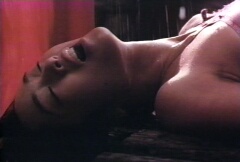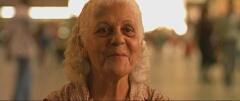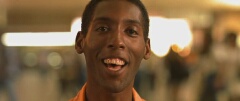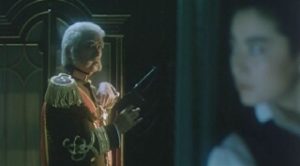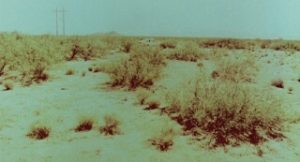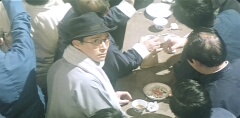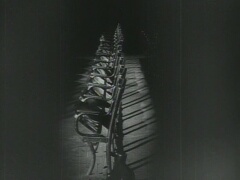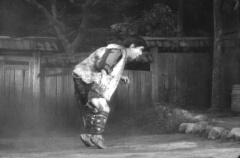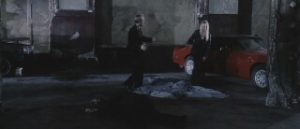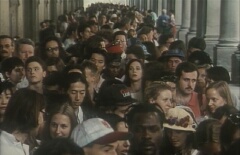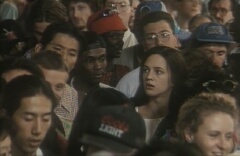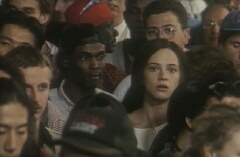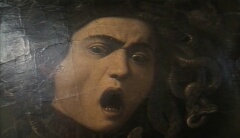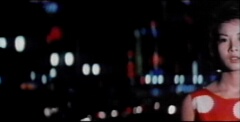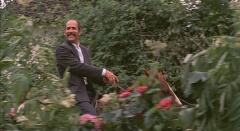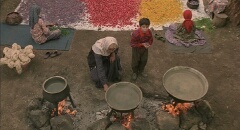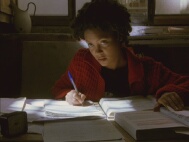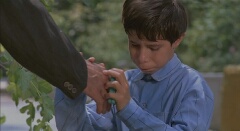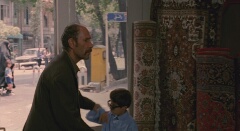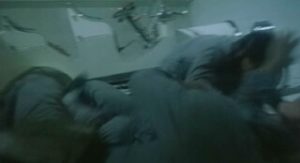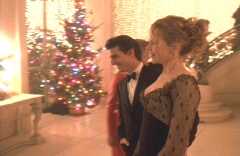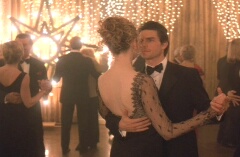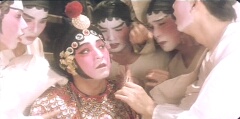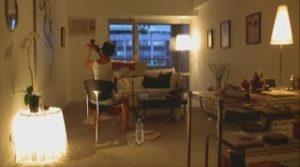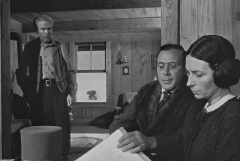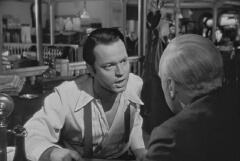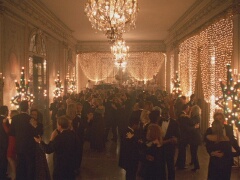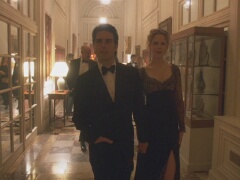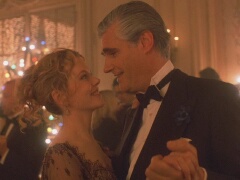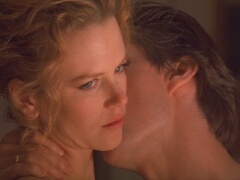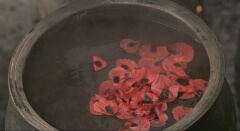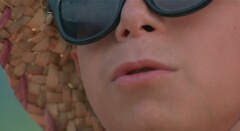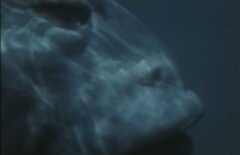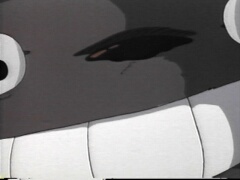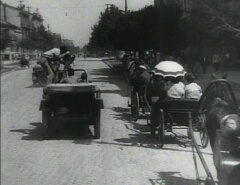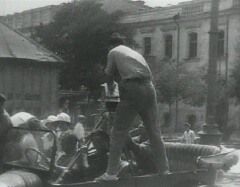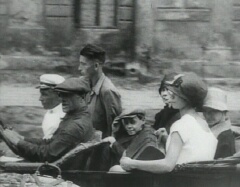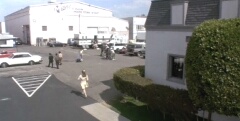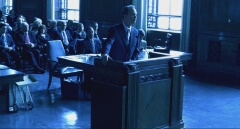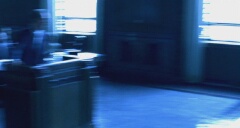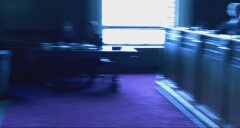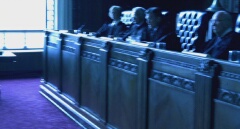Section 1 – Quality
This section explores some of the elements at play in the construction of a shot. As the critics at Cahiers du cinéma maintained, the “how” is as important as the “what” in the cinema. The look of an image, its balance of dark and light, the depth of the space in focus, the relation of background and foreground, etc. all affect the reception of the image. For instance, the optical qualities of grainy black and white in Battle of Algiers (Gillo Pontecorvo, Maarakat madinat al Jazaer, Algeria, 1965) seem to guarantee its authenticity. On the other hand, the shimmering Technicolor of a musical such as Singin’ in the Rain (Stanley Donen, 1952) suggests an out-of-this-world glamor and excitement.
COLOR
Early films were shot in black and white but the cinema soon included color images. These images were initially painted or stencilled onto the film but by the 1930s filmmakers were able to include color sequences in their films. Apart from the added realism or glamor that a color image could provide, color is also used to create aesthetic patterns and to establish character or emotion in narrative cinema.
In Federico Fellini’s extravagant Juliet of the Spirits (Giulietta degli Spiriti, 1965) colors separate the bourgeois reality and the fantasy daydreamings of the title character, who partyhops between black and white and reds and purples.
Juliet of the Spirits was the first Fellini film in color, and he intended to make full use of it. In order to further enhance the contrast with his previous work, he cast his favorite actress and wife Giulietta Massina, the protagonist of Fellini’s earlier successes such as Nights of Cabiria (Le Notti di Cabiria, 1957) in which she plays a destitute hooker in a grim suburban environment. Now Fellini has the same actress play a rich housewife in luscious technicolor, obviously signaling a clear turning point from his early Neorealism-inspired films.
Contrary to popular belief (and Goethe), colors do not necessarily carry exclusive meanings. Compare the use of red in Ingmar Bergman’s Cries and Whispers (Viskingar Och Rop, 1972),
and Zhang Yimou’s Ju Dou (1990), for example.
While Zhang exploits red as a cliched signifier of unrestrained passion, Bergman associates the color with stagnation and contaminated blood.
CONTRAST
The ratio of dark to light in an image. If the difference between the light and dark areas is large, the image is said to be “high contrast”. If the difference is small, it is referred to as “low contrast” Most films use low contrast to achieve a more naturalistic lighting. High contrast is usually associated with the low key lighting of dark scenes in genres such as the horror film and the film noir. A common cliche is to use contrast between light and dark to distinguish between good and evil. The use of contrast in a scene may draw on racist or sexist connotations.
For instance, this shot from Orson Welles’ Touch of Evil (1958) employs high contrast to further emphasize racial differences between a blonde American woman and a menacing Mexican man.
DEEP FOCUS
Like focus. In these two shots from Touch of Evil (Orson Welles, 1958) Besieged (L’Assedio, Bernardo Bertolucci,1998) all of the different planes of the image are given equal importance through deep focus, not only to the characters (like the man peeking at the window in the first image), but also to the spaces (Shanduray’s basement room in the second).
While deep focus may be used occasionally, some auteurs use it consistently for they believe it achieves a truer representation of space. Directors like Jean Renoir, Orson Welles, Hou Hsao-Hsien, or Abbas Kiarostami all use deep focus as an essential part of their signature style.
SHALLOW FOCUS
A restricted depth of field, which keeps only one plane in sharp focus; the opposite of deep focus. Used to direct the viewer’s attention to one element of a scene. Shallow focus is very common in close-up, as in these two shots fromCentral Station (Central do Brasil, Walter Selles, Brazil, 1998).
Shallow focus suggests psychological introspection, since a character appears as oblivious to the world around her/him. It is therefore commonly employed in genres such as the melodrama, where the actions and thoughts of an individual prevail over everything else.
DEPTH OF FIELD
The distance through which elements in an image are in sharp focus. Bright light and a narrow lens aperture tend to produce a larger depth of field, as does using a wide-angle rather than a long lens. A shallow depth of field is often used as a technique to focus audience attention on the most significant aspect of a scene without having to use an analytic cut-in.
Depth of field is directly connected, but not to be confused, with focus. Focus is the quality (the “sharpness” of an object as it is registered in the image) and depth of field refers to the extent to which the space represented is in focus. For a given lens aperture and level of lighting, the longer the focal distance (the distance between the lens and the object that is in focus) the greater the focal depth. For a given focal distance, the greater the level of lighting or the narrower the aperture, the greater the focal depth. For that reason, close-up shooting and shooting in low light conditions often results in images with very shallow depth of field. An image with shallow depth of field, as this frame fromPeking Opera Blues (Do Ma Daan, Tsui Hark , 1986), has some elements in focus, but others are not.
EXPOSURE
A camera lens has an aperture that controls how much light passes through the lens and onto the film. If the aperture is widened, more light comes through and the resultant image will become more exposed. If an image is so pale that the detail begins to disappear, it can be described as “overexposed”. Conversely, a narrow aperture that allows through less light will produce a darker image than normal, known as “underexposed”. Exposure can be manipulated to guide an audience’s response to a scene.
In his film Traffic (2000), Steven Soderbergh decided to shot all of the sequences in the Northern Mexico desert overexposed. The resulting images give an impression of a barren, desolated land being mercilessly burnt by the sun, a no-man’s land over which police and customs have no control.
RACKING FOCUS
Racking focus refers to the practice of changing the focus of a lens such that an element in one plane of the image goes out of focus and an element at another plane in the image comes into focus. This technique is an even more overt way of steering audience attention through the scene, as well as of linking two spaces or objects. For instance in this scene from Peking Opera Blues (Do Ma Daan, Tsui Hark, Honk Kong, 1986), a connection is made between an activist in hiding and a police officer who is pursuing him.
Racking focus is usually done quite quickly; in a way, the technique tries to mimick a brief, fleeting glance that can be used to quicken the tempo or increase suspense.
RATE
A typical sound film is shot at a frame rate of 24 frames per second. If the number of frames exposed in each second is increased, the action will seem to move more slowly than normal when it is played back. Conversely, the fewer the number of frames exposed each second, the more rapid the resulting action appears to be. The extreme case of frame rate manipulation is stop-motion, when the camera takes only one frame then the subject is manipulated or allowed to change before taking another frame.
In this clip from Vertov’s Man with the Movie Camera (Chelovek s kinoapparatom, USSR, 1929) stop motion is used to give the impression that the chairs open up by themselves.
In Kurosawa’s Seven Samurai (Shichinin no samurai, Japan, 1954), slow motion is used to contrast the emotional rescue of a child with the death of the man who kidnapped him.
TELEPHOTO SHOT
An image shot with an extremely long lens is called a telephoto shot. The effect of using a long lens is to compress the apparent depth of an image, so that elements that are relatively close or far away from the camera seem to lie at approximately the same distance. In this first shot from Payback (Brian Helgeland, 1999), we can clearly see there is a considerable distance beteen the fallen body and the red car.
Yet, when a telephoto lens is used for a close-up of Mel Gibson, his face looks like it is pressed against the car! Here a telephoto lens create a canted framing to suggest the physical and psychological disarray of a man who has been betrayed, shot, and left for dead.
ZOOM SHOT
The zoom shot uses a lens with several elements that allows the filmmaker to change the focal length of the lens (see crane or medium long shot of people cueing up at a museum’s entrance to a medium close-up of the female protagonist.
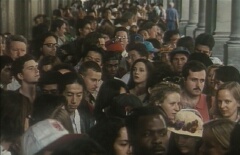 |
Few cinematic techniques are used in isolation. Notice how the woman “helps” the zoom to achieve its purpose of singling her out by moving around.
In another clip from the same film, a zooms is used to offer a more detailed view of an object. Furthermore, as we move closer and closer to the painting (Caravaggio’s Head of Medusa, 1590-1600) , both our attention and tension are increased.
Section 2 – Framing
In one sense, cinema is an art of selection. The edges of the image create a “frame” that includes or excludes aspects of what occurs in front of the camera — the “profilmic event”. The expressive qualities of framing include the angle of the camera to the object, the aspect ratio of the projected image, the relationship between camera and object, and the association of camera with character. In Cruel Story of Youth (Seishun zankoku monogatari, Oshima Nagisa, 1960) the radical decentering of the character in relation to the frame marks their failed struggle to find a place in their world.
ANGLE OF FRAMING
Many films are shot with a camera that appears to be at approximately the same height as its subject. However, it is possible to film from a position that is significantly lower or higher than the dominant element of the shot. In that case, the image is described as low angle or high angle respectively. Angle of framing can be used to indicate the relation between a character and the camera’s point of view. Or can simply be used to create striking visual compositions.
Camera angle is often used to suggest either vulnerability or power. In The Color of Paradise (Rang-e Khoda,1999) the father, who rules absolute over his family, is often portrayed from a low angle, therefore aggrandizing his figure.
On the other hand, his blind son Mohammad and his elderly grandmother are often shot from a high angle, emphasizing their dependence and smallness. These interpretations are not exclusive, however. The relation between camera and subject can be rendered ironic, or it may suggest more the subject of perception than to the state of the object. The father in this film is so busy smiling at his fiancee that he falls off his horse, while Mohammed and her granny seen from above may also indicate that God is watching over them, and keeping them under protection.
ASPECT RATIO
The ratio of the horizontal to the vertical sides of an image. Until the 1950s almost all film was shot in a 4:3 or 1.33:1 aspect ratio. Some filmmakers used multiple projectors to create a wider aspect ratio whereas others claimed that the screen should be square, not rectangular. Widescreen formats became more popular in the 1950s and now films are made in a variety of aspect ratios — some of the most common being 1.66:1, 1.76:1, 1.85:1, and 2.35:1 (cinemascope).
Widescreen films are often trimmed for television or video release, effectively altering the original compositions. Some DVD’s have the option of showing the film in its original format and in a reduced ratio that fits the TV screen. Compare the same frame from Bertolucci’s Besieged (L’Assedio, 1998). Objects appear much more cramped with the reduced aspect ratio, giving an impression of physical (and psychological) space different from the theatrical release.
LEVEL OF FRAMING
Not only the angle from which a camera films but the height can also be a significant element in a film. A low-level camera is placed close to the ground whereas a high-level camera would be placed above the typical perspective shown in the cinema. Camera level is used to signify sympathy for characters who occupy particular levels in the image, or just to create pleasurable compositions. Camera level is obviously used to a greater advantage when the difference in height bewteen objects or characters is greater. In The Color of Paradise (Rang-e Khoda, Iran, 1999) Majid Majidi uses different camera height to emphasize the difference between Mohammad and his father.
In the first image, the camera concentrates on Mohammad as he recognizes his father’s hand, after patiently waiting for him for hours. The father is almost absent from the scene; only the part of him that Mohammad touches is visible, therefore increasing our empathy with the blind boy. On the second image, camera level is adjusted to the father’s size, making Mohammed a puny, defenceless figure in a world that overcomes him. The first shot is on Mohammad’s School for the Blind, while the second is on a shop in Tehran. Through different camera levels, the director makes clear where Mohammad’s fits and where he does not.
CANTED FRAMING
Canted Framing is a view in which the frame is not level; either the right or left side is lower than the other, causing objects in the scene to appear slanted out of an upright positon.Canted framings are used to create an impression of chaos and instability. They are therefore associated with the frantic rhythms of action films, music videos and animation.
Many Hong Kong films of the 80s and 90s blend elements of the genres mentioned above, for instance Tsui Hark’s Peking Opera Blues (Do Ma Daan, 1986). These films employ unconventional framings to achieve their signature dizzing, freewheeling style. Canted framings are also common when shooting with a Steadycam.
FOLLOWING SHOT
A shot with framing that shifts to keep a moving figure onscreen. A following shot combines a camera movement, like tracking, craning, with the specific function of directing our attention to a character or object as he/she/it moves inside the frame. In this shot from Eyes Wide Shut (Stanley Kubrick, 1999) the camera pans slightly to accompany a couple into the ballroom floor.
REFRAMING
Short panning or tilting movements to adjust for the figures’ movements, keeping them onscreen or centered. An important technique of continuity editing, thanks to its unobstrusive nature. The characters’ actions take precedence over the camera movements, as in this dancing scene from Kubrick’s Eyes Wide Shut (1999)
POINT-OF-VIEW SHOT
A shot taken with the camera placed approximately where the character’s eyes would be, showing what the character would see; usually cut in before or after a shot of the character looking. Horror films and thrillers often use POV shots to suggest a menacing and unseen presence in the scene. Films that use many point-of-view shots tend toward dynamic and non-naturalistic style. In this clip from Peking Opera Blues (Do Ma Daan, Tsui Hark, Hong Kong, 1986) the female impersonator’s fear of the soldier who attempts to procure him for his general is rendered comic by the cut to POV and wide angle.
POV is one of the means by which audiences are encouraged to identify with characters. However, it is actually a relatively rare technique: identificatory mechanisms rely more on sympathetic character and the flow of narrative information than on simple optical affiliation.
WIDE ANGLE LENS
A lens of short focal length that affects a scene’s perspective by distorting straight lines near the edges of the frame and by exaggerating the distance between foreground and background planes. In doing so it allows for more space to enter the frame (hence the name “wide”), which makes it more convenient for shooting in a closed location, for instance a real room, rather than a three-wall studio room. In addition, a wider lens allows for a bigger depth of field. In 35mm filming, a wide angle lens is 30mm or less. See also telephoto lens.
Since a wide angle lens distorts the edges of an image, as in this frame from Yi Yi (Edward Yang, Taiwan, 2000), extreme wide lenses are avoided in naturalistic styles, or they are used in unrestrained or open spaces, with no converging lines around the edges of the frame.
Section 3 – Scale
If the same object were filmed at different shot scales it would often signify quite differently. Shot scale can foster intimacy with a character, or conversely, it can swallow the character in its environment.Orson Welles exploited divergent shot scales in Citizen Kane (1941) to demonstrate the changing power relationship between Charles Foster Kane and his lawyer. As a boy, his figure is lost in the snow at the back of the shot as the lawyer arranges for his adoption. As a young man he rebels against Bernstein’s oversight, rising in the frame as he asserts himself.
EXTREME LONG SHOT
A framing in which the scale of the object shown is very small; a building, landscape, or crowd of people will fill the screen. Usually the first or last shots of a sequence, that can also function as establishing shots.. The following examples of framing from Eyes Wide Shut (Stanley Kubrick, 1999) and A Summer Tale (Conte d’Été, Eric Rohmer, 1996) well illustrate the range of uses for this particular shot scale.
 |
These two extreme long shots are also establishing shots. However, their primary function is different. Whereas Rohmer give us a standard establishing shot that introduces the locale where the main characters are about to meet, Kubrick uses the ballroom shot mainly as a brief transition between two more important scenes. While the two shots above have similar sizes, some extreme long shots can be significantly larger, particularly if shot from the air with the help of cranes or helicopters. This kind of extreme long shot is also called bird’s eye view shot, since it gives an aerial perspective of the scene.
LONG SHOT
A framing in which the scale of the object shown is small; a standing human figure would appear nearly the height of the screen. It makes for a relatively stable shot that can accomodate movement without reframing. It is therefore commonly used in genres where a full body action is to be seen in its entirety, for instance Hollywood Musicals or 1970s Martial Arts films.
 |
Another advantage of the long shot is that it allows to show a character and her/his surroundings in a single frame, as in these two images from Eyes Wide Shut (Stanley Kubrick, 1999) and A Summer Tale (Conte d’Été, Eric Rohmer, 1996).
MEDIUM LONG SHOT
Framing such than an object four or five feet high would fill most of the screen vertically. Also called plain américain, given its recurrence in the Western genre, where it was important to keep a cowboy’s weapon in the image.
Eyes Wide Shut (Stanley Kubrick, 1999)
 |
A Summer Tale (Conte d’Été) France Eric Rohmer, 1996
MEDIUM CLOSE-UP
A framing in which the scale of the object shown is fairly large; a human figure seen from the chest up would fill most of the screen. Another common shot scale.
Eyes Wide Shut (Stanley Kubrick, 1999)
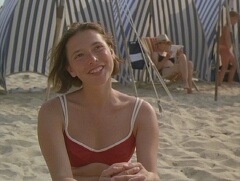 |
A Summer Tale (Conte d’Été, Eric Rohmer, 1996)
CLOSE-UP
A framing in which the scale of the object shown is relatively large. In a close-up a person’s head, or some other similarly sized object, would fill the frame. Framing scales are not universal, but rather established in relationship with other frames from the same film. These two shots from Eyes Wide Shut and A Summer Tale can be described as close-ups, even if one starts at the neck and the second at the upper chest..
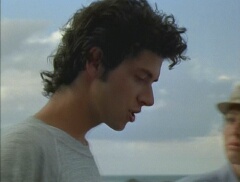 |
Framing scales are usually drawn in relationship to the human figure but this can be misleading since a frame need not include people. Accordingly, this shot from The Color of Paradise (Rang-e Khoda, Majid Majidi, Iran,1999) is also a close-up.
EXTREME CLOSE-UP
A framing in which the scale of the object shown is very large; most commonly, a small object or a part of the body usually shot with a zoom lens. Again, faces are the most recurrent images in extreme close-ups, as these images fromThe Color of Paradise (Rang-e Khoda,Majid Majidi, 1999),
The Stendhal Syndrome (La Sindrome di Stendhal, Dario Argento, 1996),
and My Neighbor Totoro (Tonari No Totoro, Miyazaki Hayao, 1988) demonstrate. With regard to the latter, it should be noted that while all of these film terms equally applies to animation, the technical procedure to achieve a particular effect can be very different. For instance this last frame is a drawing of Totoro’s teeth, not a zoom on his face, as it would have been the case in a live-action film.
Section 4 – Movement
There are many ways to move a camera: in fluid long takes, rapid and confusing motions, etc. that establish the tracking shot. Furthermore, one soon realizes that the whole process is probably being mirrored by a second car, in order to film the first one.
Scenes taken from both cameras are playfully incorporated into the film. Was this image of the car passing by taken by the first or the second car/camera unit?
CRANE SHOT
A shot with a change in framing rendered by having the camera above the ground and moving through the air in any direction. It is accomplished by placing the camera on a crane (basically, a large cantilevered arm) or similar device. Crane shots are often extreme long shots: they lend the camera a sense of mobility and often give the viewer a feeling of omniscience over the characters.
Crane shots can also be used to achieve a flowing rhythm, particularly in a long take, as in this clip from The Player (Altman, 1992)
HANDHELD CAMERA, STEADYCAM
The use of the camera operator’s body as a camera support, either holding it by hand or using a gyroscopic stabilizer and a harness. Newsreel and wartime camera operators favored smaller cameras such as the Eclair that were quickly adopted by documentarist and avant-garde filmmakers, notably the cinéma verité movement of the 1950s and 1960s. They were also used by young filmmakers since they were cheap and lent the images a greater feeling of sponteneity. At the time this challenge to prevailing standards was perceived as anti-cinematic but eventually it came to be accepted as a style. Whereas hand held cameras give a film an unstable, jerky feel, they also allows for a greater degree of movement and flexibility than bulkier standard cameras –at a fraction of the cost. Filmmakers now are experimenting with digital video in a similar way. Gyroscopically stabilized “steadicams” were invented in the 1970s and made it possible to create smooth “tracking” shots without cumbersome equipment. More recently, they are extensively used in music videos and in the films of the Dogme movement, such as Lars Von Trier’s Dancer in the Dark(Denmark, 2000)

Ironically, while today’s steadicams allow for a fairly stable image, Lars Von Trier and his accolites prefer to exacerbate the jerkiness and unstability traditionally associated with these cameras as a marker of visceral autorial intervention. In fact, combining steadicam shooting with aggressive jump cuts , or even by shooting on low definition formats, Dogme and other radical filmmaking movements attempt to create a new cinematic look as further away as possible from mainstream Hollywood.
PAN
A camera movement with the camera body turning to the right or left. On the screen, it produces a mobile framing which scans the space horizontally. A pan directly and immediately connects two places or characters, thus making us aware of their proximity. The speed at which a pan occurs can be expoited for different dramatic purposes. For instance, in a Mizoguchi or a Hou film, two characters may be having a conversation in a room, and after several minutes, the camera might pan and reveal a third person was also present, thus changing the whole implication of the scene. In a film like Traffic (Steven Soderbergh, 2000), on the other hand, pans are usually very quick, suggesting that characters have no time to waste, and that decisions must be taken fast, therefore contributing to the sense of imminent danger and moral urgency that the films tries to communicate.
In the clip above, the defense lawyer has just finished a long, clever speech, yet the judge has no second thoughts on his verdict, nor any pity for the (presumably guilty) accused and their rich legal cohorts. Lastly, a pan does not necessarily mean that the camera moves along an horizontal line. This clip from The Stendhal Syndrome (La Sindrome di Stendhal, Dario Argento,1996), illustrates what we could call a 360° pan.
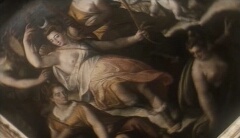
TILT
A camera movement with the camera body swiveling upward or downward on a stationary support. It produces a mobile framing that scans the space vertically. Its function is similar to that of tracking shots, albeit on a vertical axis. In this clip from Besieged (L’Assedio, Italy, 1998) Bernardo Bertolucci uses a tilt to establish the social (and even racial) distance between an African housemaid and her wealthy English employer.
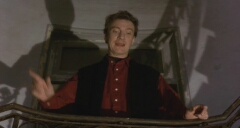
A tilt usually also implies a change in the offscreen space. This can be exploited for suspense, since a sense of anticipation grows in the viewer as the camera movement forces her/his attention in a precise direction, yet never knowing when it will stop, nor what will be found there.
TRACKING SHOT
A mobile framing that travels through space forward, backward, or laterally. See also pan, and continuity editing style. As cameras became lighter and match on action.

The first is a classic tracking shot, with the camera on rails sideways to the character that is moving, following the child as the trains departs. The second uses the train as a dolly, as it moves away from the running child. Indeed, tracking shots are one of the most suggestive and creative camera movements, one that can be accomplished in a number of clever ways. Not surprisingly, some long takes.
WHIP PAN
An extremely fast movement of the camera from side to side, which briefly causes the image to blur into a set of indistinct horizontal streaks. Often an imperceptible cut will join two whip pans to create a trick transition between scenes. As opposed to action or continuity style– whip pans always stand out, given their abrupt, brisk nature. Commonly used in flashy action genres such as kung-fu movies from the 70s, like Fists of Fury (Tang Shan Da Xiong, Wei Lo, Honk Kong, 1971).


